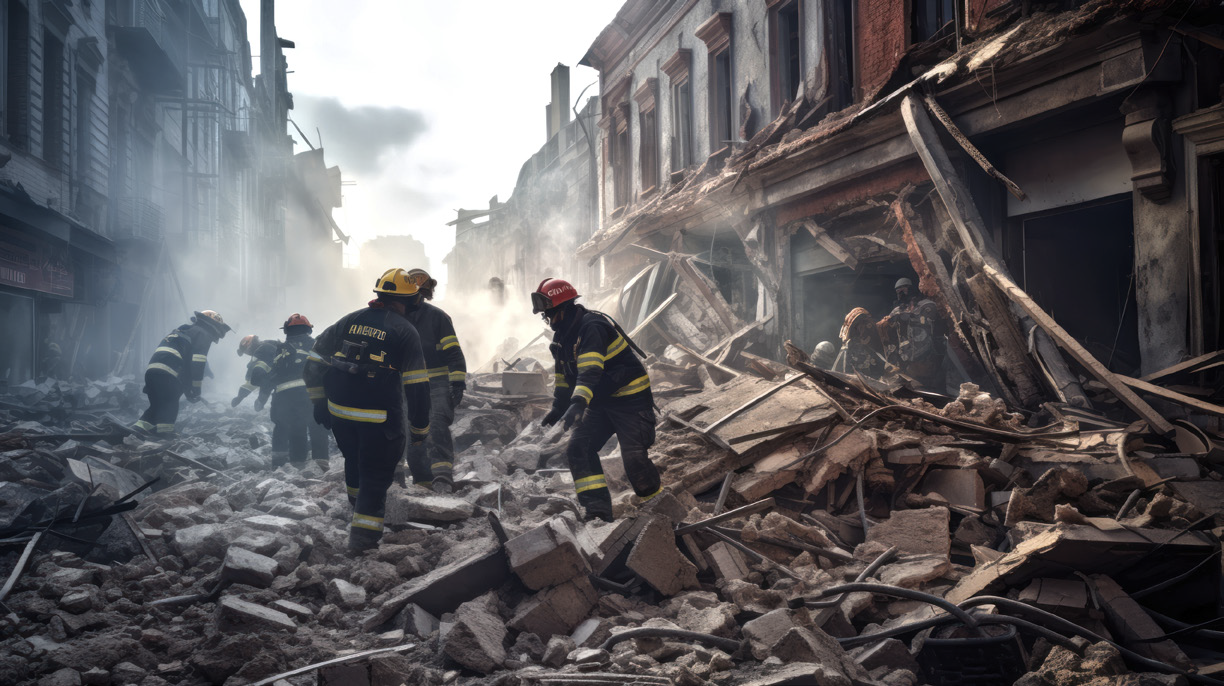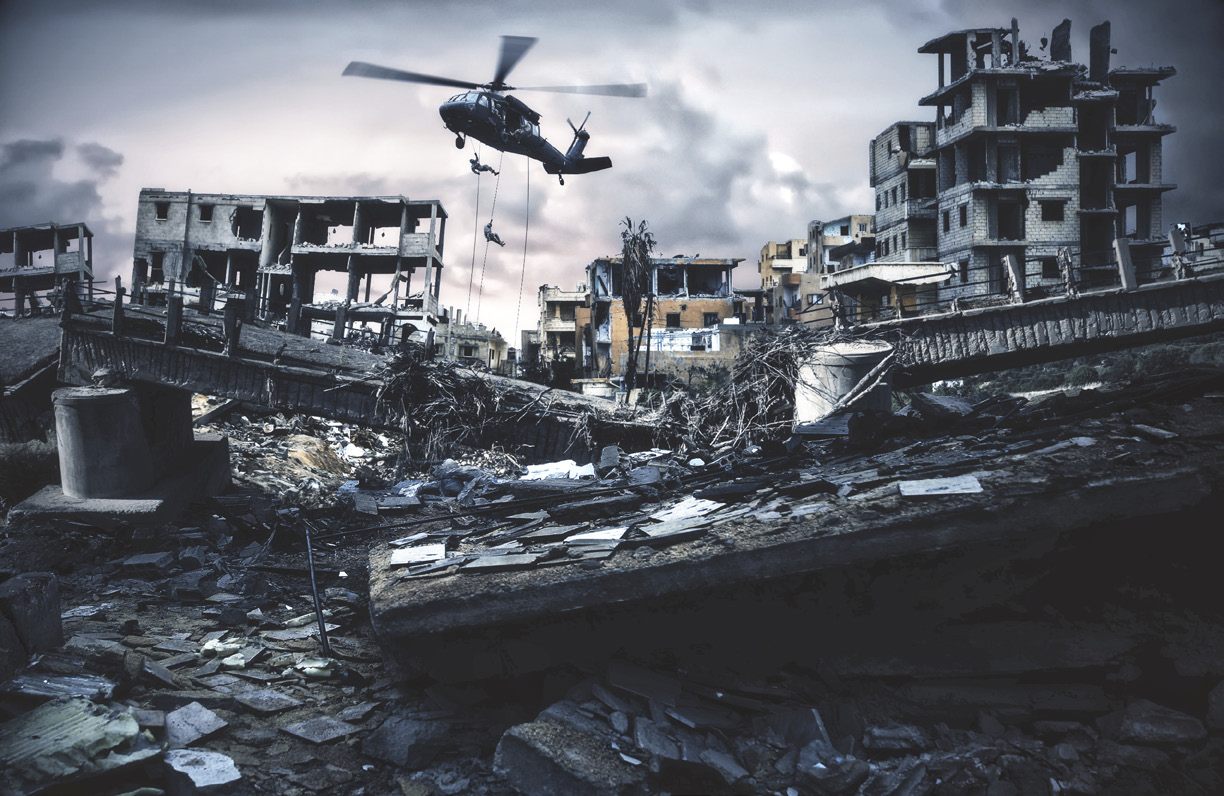In the aftermath of disasters, whether natural disasters or as the result of conflict, effective communication can be the difference between life and death. In these situations, it’s vital that lines of communication are quickly established. This enables agencies to get a clear picture of the situation on the ground, and also allows for coordinated response and recovery efforts to happen so that the necessary aid and resources reaches the right places as soon as possible.

However, communication in these situations is often challenging. Terrestrial infrastructure may be lacking or become overloaded as a result of the disaster, and additionally, there might also be damage to infrastructure that disrupts existing wired and cellular communication networks.
Satellite connectivity on the other hand has several distinctive features that make it very well suited for use in disaster situations, yet NGOs and other organisations are not always using it to its full potential. Why is that and what can we do about it?
Satellite Is A
Critical Enabler
In Disasters
Let’s begin by looking at why satellite connectivity is so important in a disaster. First, its global reach means that it can be used to provide immediate and reliable communication networks anywhere in the world. And with the ability to operate independently of other communication networks, satellite terminals can be used without the need for infrastructure to already be in place.
This means that a communication channel can be easily established regardless of the conditions in the area, even when infrastructure is completely lacking or has been damaged. With the correct expertise and equipment, satellite terminals are generally easy to install and set up.
Additionally, satellite terminals can be configured to get the service from a teleport located in another country so that there is no dependency on local personnel who may also be affected by the disaster.
Given these characteristics, it’s clear that satellite connectivity is a key enabler and should be incorporated into disaster planning and recovery.
Barriers To
Maximizing
SATCOM’s
Potential
The satellite industry is highly dynamic, and innovations and technological developments are happening all the time, which could enormously benefit regions experiencing disaster events.
However, many regions are still reliant on older equipment, and are not benefiting from these technological innovations. This comes largely down to complex political and indeed financial reasons, although challenges around logistics and resource management also play a part, particularly when dealing with geographically remote locations.
And even if the latest SATCOM equipment is available, without the right expertise to hand, there’s always a possibility that it may not be used correctly, or fully used.
It’s true that SATCOM technology has improved a lot in the recent years, to the point where there are some satellite terminals that can be easily installed even by people with very limited technical skills. However, not all equipment is quite so easy to use, and so it’s not unusual for organisations to view the technology as technically complex and even intimidating.
This creates a real barrier to its use. To overcome this, and to make satellite technology much more inclusive, it’s important that NGOs are educated and trained about satcom systems and available resources. It’s important that as an industry, we raise awareness among NGOs about the available resources that can support them to leverage satcom in both disaster planning and recovery situations.
There are many resources available in different countries that are not being used efficiently, in terms of both available satcom equipment and qualified engineers. If organizations operating in disaster scenarios are aware of all available resources, they may be ble to deploy a communication channel much faster than they can currently.

Expertise
Where
NeededOf course, it’s important that field engineers are well-equipped and trained to install and maintain satellite terminals effectively. This is why Oasis is a proud member of GVF/GSOA and indeed invest lot of effort and energy into on-going training and equipping of field engineers.
But aside of this, situations will also arise when qualified field engineers are not readily available on site to establish the satellite link. In these scenarios, there is a need to guide local staff, who are not certified VSAT engineers, to bring the satellite link up. In these circumstances, the set up just needs to be good enough to work for a limited time, at least until someone qualified can reach the site and fix things up.
We have teams that are spread all over the world, so can usually dispatch someone fairly local, fast enough to provide a second line of support, if not a first one. We have constant access to local engineers with whom we work all the time, not only when there is a crisis. And crucially, we have access to wide inventory of equipment located in many countries around the globe, which helps to ensure that equipment can quickly be delivered to the affected area.
Education+
Training
Is KeyAlthough we’re an established VSAT company, we haven’t previously been involved with deploying satellite technology in emergency or disaster situations. However, we’re quite familiar with emergency situations that require swift response as well as dealing with difficult logistics challenges such as inaccessible roads, poor weather and security concerns.
For example, some years ago, there was a highly unusual satellite failure that suddenly affected thousands of Earth stations, some of which were providing critical infrastructure, such as GSM connectivity. All of a sudden, we were inundated with urgent requests to send engineers in several countries to migrate services to other satellites.
In the Democratic Republic of Congo alone, we dispatched more than 40 engineers to some of the most extreme locations in the country. To access some locations, we had to convoy with the army, and in other areas we had to get to sites on motorbikes, or even navigate with canoes or hike by foot.
Experiences such as this makes us well placed to help guide NGOs, agencies and field engineers to deploy satellite technology in emergency situations. We’re thrilled to be involved in a wonderful training project in Ghana that is being run in partnership with a local university, the UENR in Sunyani, and funded by the World Bank.
Under the project, we’ll be providing training to future field engineers under a structured curriculum of academic courses, which will cover both theoretical and practical aspects of satcom. The trainees will obtain both certifications that are recognized by the industry, and academic points that will be counted in their academic degree.
We’ve recently developed and launched the curriculum, and the first course is planned for June of 2024, with 25 subscribed participants. There is an expectation that the center will train at least 50 field engineers each year and will be hub for young students from neighboring countries as well.
Initiatives such as this are an important part of ensuring that SATCOM technology is being fully used by NGOs and other organizations. Alongside the training project in Ghana taking place this year, we also organize training sessions each year in different parts of this world. Last year, we trained people in Southeast Asia and, this year, we’re focusing on West Africa at the center in Ghana and have also delivered some small-scale training in Latin America.
In addition to the main training events, we also hold sporadic training activities as and when needed. Our model of boots on the ground and equipment on the ground is highly relevant to the disaster response industry. While we are new to the field of disaster preparedness and recovery, we are eager to learn and to work with new partners.
Role Of Planning+
Coordination
SATCOM clearly has a vital role to play in disaster recovery by facilitating emergency communication in affected areas. However, it is essential that it’s use is planned for when governments, NGOs and organizations develop disaster preparedness strategies. This will help to ensure that adequate funding and expertise is in place for fast roll out of satellite communication networks in the event of a disaster.

Short-term and mid-term contingency plans are crucial for successful disaster response, as is access to a network of experts responsible for coordinating recovery efforts. Only with such coordination can regions fully harness the potential of satellite connectivity to support disaster response and recovery.
Getting this right is a critical part of ensuring that the people affected by disasters can access the help and support they need, so that they can stay safe and start to recover from the disaster event.
www.oasisnetworks.net

